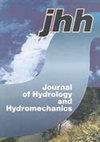A theoretical underpinning of the pesticide Groundwater Ubiquity Score (GUS)
IF 2.3
4区 环境科学与生态学
Q3 WATER RESOURCES
引用次数: 0
Abstract
The Groundwater Ubiquity Score (GUS) is widely used to indicate the relative leachability of pesticides based on the soil half-life and the adsorption partition coefficient. In this manuscript, we derive mathematically the Theoretical Groundwater Ubiquity Score (TGUS) that, based on considerations of the preferential movement of pesticides to groundwater and a first-order pesticide degradation model, leads to a similar function as the GUS model. In the preferential flow model, movement to groundwater is fast, and the adsorption partition coefficient is thus not used for calculating the travel time to the groundwater (as it is in the advective-dispersive equation) but rather only determines the distribution of the pesticide between the water and soil phases. Both the GUS and TGUS models well predict the groundwater contamination of the originally studied pesticides for rainfall event(s) that caused pesticide leaching from 30 days after application. The theoretically derived Groundwater Ubiquity Score (TGUS) shows, in accordance with experimental evidence, that for leaching events shortly after spraying, the mass lost to (and resulting concentration in) groundwater is inversely related to the adsorption partition coefficient and not necessarily to the GUS index.农药地下水普遍性评分(GUS)的理论基础
根据土壤半衰期和吸附分配系数,地下水独特性得分(GUS)被广泛用于表示农药的相对浸出性。在本手稿中,我们根据农药向地下水的优先流动和一阶农药降解模型,从数学上推导出了理论地下水泛滥得分(TGUS),其函数与 GUS 模型类似。在优先流动模型中,向地下水的流动是快速的,因此吸附分配系数并不用于计算向地下水的流动时间(就像在平流-分散方程中那样),而只是决定农药在水相和土相之间的分布。GUS 和 TGUS 模型都能很好地预测最初研究的农药在施用后 30 天内造成农药沥滤的降雨事件对地下水的污染情况。理论上得出的地下水普遍性得分(TGUS)显示,与实验证据一致,在喷洒后不久发生的沥滤事件中,流失到地下水中的质量(以及由此产生的浓度)与吸附分配系数成反比,而不一定与 GUS 指数成反比。
本文章由计算机程序翻译,如有差异,请以英文原文为准。
求助全文
约1分钟内获得全文
求助全文
来源期刊
CiteScore
4.20
自引率
5.30%
发文量
30
审稿时长
>12 weeks
期刊介绍:
JOURNAL OF HYDROLOGY AND HYDROMECHANICS is an international open access journal for the basic disciplines of water sciences. The scope of hydrology is limited to biohydrology, catchment hydrology and vadose zone hydrology, primarily of temperate zone. The hydromechanics covers theoretical, experimental and computational hydraulics and fluid mechanics in various fields, two- and multiphase flows, including non-Newtonian flow, and new frontiers in hydraulics. The journal is published quarterly in English. The types of contribution include: research and review articles, short communications and technical notes. The articles have been thoroughly peer reviewed by international specialists and promoted to researchers working in the same field.

 求助内容:
求助内容: 应助结果提醒方式:
应助结果提醒方式:


